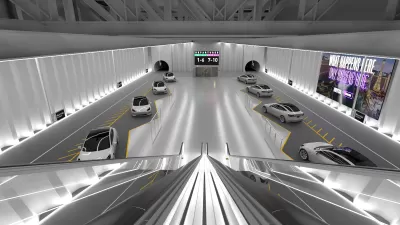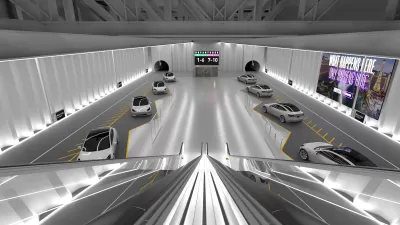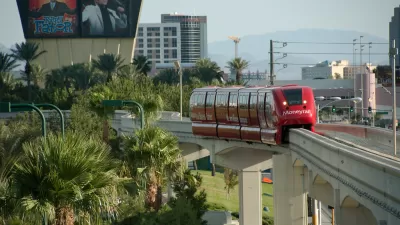Elon Musk poked the transit planning community on social media last week with a rendering of the forthcoming Las Vegas Convention Center Loop tunnel.

Alissa Walker provides commentary on Elon Musk's big reveal, timed perfectly for the Tesla earnings call last week, of the Boring Company’s Las Vegas Convention Center Loop (LVVC Loop) tunnel system.
According to Walker, the peek at plans for the LVVC Loop, "in typical Musk fashion, is somehow more visually underwhelming than the previous version and also manages to contradict much of what he’s previously said about it."
"'Coming soon,' Musk tweeted, along with an image of an escalator descending into an underground lot ringed with vehicles, a pair of tunnels relegated to the background against the far wall. It not only looks very different from the cavernous, vaguely futuristic station that was originally proposed, it’s also a dramatic departure from the renderings presented at the beginning of the year," writes Walker.
"The project was originally billed as a people mover, with sleek 12-passenger 'pods' that looked like minivans encased in privacy glass aiming to move 4,400 people per hour. The new rendering, however, shows Tesla Model 3 sedans instead, which could fit five passengers at most, reducing its capacity by roughly half."
Then there was this doozy, which inspired a wave of mockery on social media:
Individualized mass transit is the future
— Elon Musk (@elonmusk) July 22, 2020
The article includes a lot more detail on how the LVCC Loop project, as it is officially known, came to be, and next steps on the way to an expected opening in January 2021.
Previous Planetizen coverage of the Las Vegas Convention Center Loop:
- The Boring Company Gets Paid (May 2019)
- Conflicts With the Las Vegas Monorail Complicating Elon Musk's Tunnel Plans (August 2019)
FULL STORY: Somehow Elon Musk’s Tesla Tunnels Are Even Less Useful Now

Maui's Vacation Rental Debate Turns Ugly
Verbal attacks, misinformation campaigns and fistfights plague a high-stakes debate to convert thousands of vacation rentals into long-term housing.

Planetizen Federal Action Tracker
A weekly monitor of how Trump’s orders and actions are impacting planners and planning in America.

In Urban Planning, AI Prompting Could be the New Design Thinking
Creativity has long been key to great urban design. What if we see AI as our new creative partner?

King County Supportive Housing Program Offers Hope for Unhoused Residents
The county is taking a ‘Housing First’ approach that prioritizes getting people into housing, then offering wraparound supportive services.

Researchers Use AI to Get Clearer Picture of US Housing
Analysts are using artificial intelligence to supercharge their research by allowing them to comb through data faster. Though these AI tools can be error prone, they save time and housing researchers are optimistic about the future.

Making Shared Micromobility More Inclusive
Cities and shared mobility system operators can do more to include people with disabilities in planning and operations, per a new report.
Urban Design for Planners 1: Software Tools
This six-course series explores essential urban design concepts using open source software and equips planners with the tools they need to participate fully in the urban design process.
Planning for Universal Design
Learn the tools for implementing Universal Design in planning regulations.
planning NEXT
Appalachian Highlands Housing Partners
Mpact (founded as Rail~Volution)
City of Camden Redevelopment Agency
City of Astoria
City of Portland
City of Laramie





























